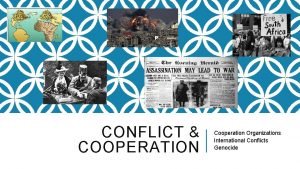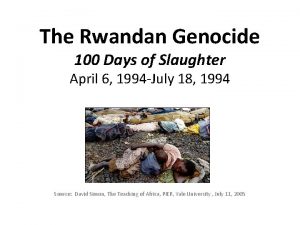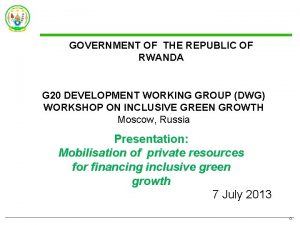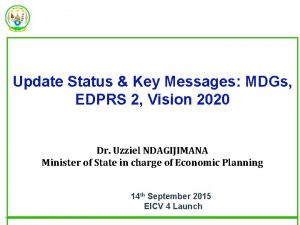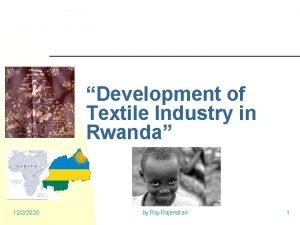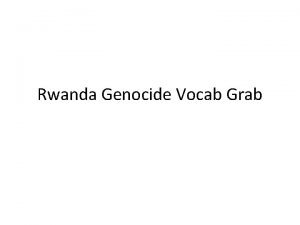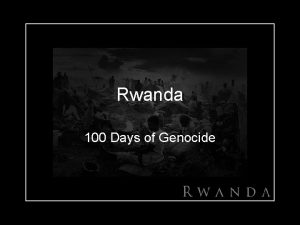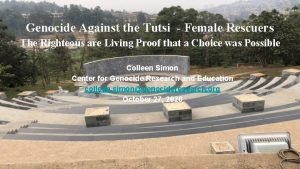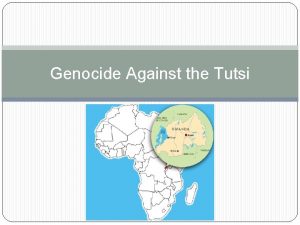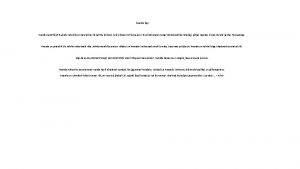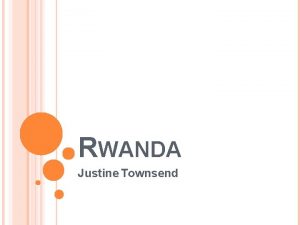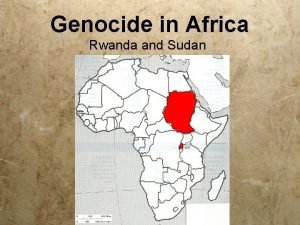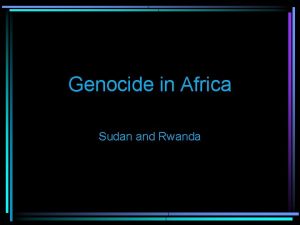The 1994 Genocide Against the Tutsi in Rwanda











- Slides: 11

The 1994 Genocide Against the Tutsi in Rwanda

Lesson overview In the next few minutes we hope you’ll learn: • Who lived in Rwanda • The impact of Europeans on Rwanda • The steps towards the Genocide • The international response to the Genocide • Resistance and rescue during the Genocide • Whethere was justice

Who lived in Rwanda? • The people of Rwanda were largely divided into three groups: Hutu (the majority), Tutsi and Twa (both groups were in the minority). • The labels of Hutu and Tutsi originally related to status. A person with status – normally associated with the ownership of cattle would be a Tutsi whereas those who farmed the land were Hutu. • However, if a Hutu was able to enrich themselves then they were granted the status of Tutsi and vice versa. • There was mixing and movement between the two levels of status. Hutu and Tutsi also shared the same traditions, spoke the same language and married each other.

What impact did Europeans have on Rwanda? • When Europeans arrived in Rwanda they did not understand this complex and sophisticated system. They wanted to rule Rwanda in the easiest and most profitable ways possible. • The Belgian imperialists made everyone in Rwanda carry an identity card. On the ID card was listed a person’s group: Hutu, Tutsi or Twa. From then on people in Rwanda were permanently labelled as one of these groups change. • The Belgians decided to use the Tutsi group to rule the country and set about discriminating against the Hutu majority.

Steps to genocide • After the Belgian colonisers left the Hutu majority took control. • Violence and persecution against the Tutsi began • Some Tutsi fled abroad to escape discrimination. • In 1990 a civil war began. • A group of ‘Hutu Power’ extremists began to plan a genocide in order to keep power.

Hate speech in Rwanda • In the early 1990 s extremists who planned the genocide worked hard to fill the air with hate speech against their Tutsi neighbours. • Tutsis were also called ‘inyenzi’ which meant ‘cockroaches’. Ordinary people were told to ‘go to work’…which many people understood meant to kill Tutsi • In July 1993 a new radio station, called RTLM, came on the air. In between the songs DJs like Habimana Kantano told their listeners that Tutsi were the ‘enemy’ and ‘accomplices’ with the rebel army that the government was fighting.

Preparing genocide • The extremists also recruited young men and trained them as killers. They were called the ‘Interahamwe’ (‘Those who fight together’) • From 1990 -93, up until a year before the genocide began, there were small but brutal attacks on groups of Tutsi civilians. • Hundreds died in massacres that historians have seen as ‘practice’ and ‘rehearsals’ for the genocide that was to come

Genocide • On April 6 th 1994 the President of Rwanda was assassinated. • This was the signal for the genocide to start. • The army and ‘Interahamwe’ began going from house to find kill Tutsi • Ordinary Hutus also joined in the killing. They murdered their Tutsi neighbours.

The international response • The United Nations had men stationed in Rwanda. • As the killing started countries like Belgium withdrew their troops • Other countries sent soldiers to rescue their citizens who lived in Rwanda…but they did not rescue Tutsis • Powerful nations like the USA refused to intervene – even as the genocidal situation became clear

Resistance and rescue • Many Tutsi fought desperately for their lives. There was brave resistance on the hills of Bisesero, for instance. • Some people, like Zura Karuhimbi, sheltered their Tutsi neighbours • More than one million Tutsi were murdered in just 100 days

Justice? • Some leaders of the genocide, such as Jean Kambanda, were convicted for genocide. Others escaped. • In Rwanda the ‘Gacaca’ courts tried local people who killed Tutsi • Tutsi who survived have to live side by side to those who killed their families, in places. • Even today the perpetrators deny that a genocide took place

